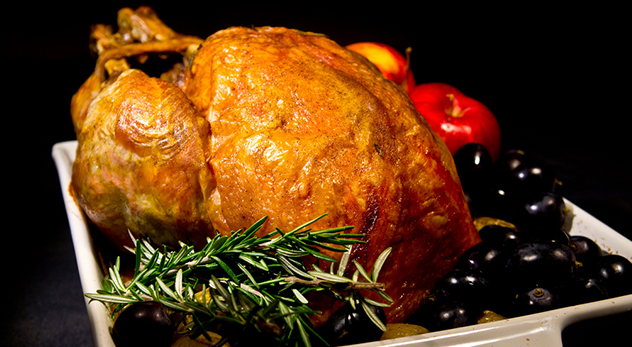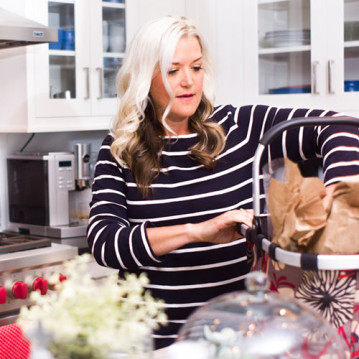
Shauna Niequist says that the secular holiday of Thanksgiving is more sacred than we might assume. (Image courtesy of Ruocaled – http://bit.ly/1aQOZXW)
On Thursday, hundreds of millions of Americans will gather to celebrate Thanksgiving–a day devoted to exuding gratitude and consuming food. According to the USDA National Agricultural Statistics Service, about 39 million families will travel to have Thanksgiving dinners where an average of $54.18 will be spent on the meal and 51 million turkeys will be consumed. In some ways, this is apropos since the first Thanksgiving consisted of a three-day feast.
But according to Shauna Niequist, this secular holiday may be more sacred than we assume. Her most recent book, Bread and Wine: A Love Letter to Life Around the Table, explores the surprising and sacred things that happen around the dinner table. She sprinkles creative recipes throughout, encouraging readers to test her concepts with friends and family. Whether you’re a seasoned chef or a reluctant meal-preparer, Niequest’s insights will draw you into the mysterious gift of sharing food with those you love. This Thanksgiving, I decided to talk to Shauna about the “meaning of eating” and the little known connection between food and faith.
JM: Well, Shauna, we’re approaching another Thanksgiving–an occasion for feasting that Americans have celebrated for decades. Is what happens at folks’ tables today different than a half-century or century ago? What’s different now?
SN: People used to spend more time at the table. And people used to have more time to spend. We’ve moved from the table to the car, many of us, and our current food culture is giving us more and more opportunities to do that: more drive thrus, more curbside delivery, more pre-packaged and pre-prepared options.
If your life is anything like mine, if we’re not careful, most of our relational connections take place either online, via text, or in a hurry—saying “hello” on the way in to church or preschool pick-up, or in and out of meetings, or on the way to somewhere else.
The table is important because the table is the place where time stops, if we choose for that to be true, if we build and adhere to that pattern. The table is where we can carve out sacred space to look people in the eye, to hear the whole story, not just the text-able sound byte.
JM: There are a lot of folks who don’t want to have people over to eat if the meal (or home) is not going to be Martha-Stewart-perfect. And of course, that gets in the way of relationships. What do you want to say to people like this?
SN: I totally get that feeling, and I’m sort of in a battle against the idea of “company.” What I mean is I think we’ve all had moments when we’re snapping at our kids, shoving things in closets, attempting recipes we’d never make for our family, because “company” is coming.
But what if all of us, together, gave up on the idea of company, of entertaining as pressurized performance art? What if we made a deal that gathering around one another’s tables was more like an extension of family, of familiarity, of the same humble soups and scrambled eggs and cheese sandwiches that we actually serve our families?
JM: Shauna, you help readers bridge what has been chronically disconnected for many Christians. Namely, you say that what happens at the altar in the sacred liturgical meal and what happens in kitchens and dining rooms and on tv trays are related. Talk about that.
SN: I think there’s a tendency to divide the sacred and the material a little too definitively—in the faith tradition I was raised in, we spend a lot of time talking about the beliefs and ideals and internal perspectives of the heart…but God created this tactile, material world on purpose, with all its tastes and scents and colors and sounds. How can we not regard those things as sacred? How can we call them anything less than divine?
And he made our bodies with a requirement for regular feeding—maybe that’s about nutrients…and maybe it’s also about an internal timer that gets us back to the table, that gets us back to community and connection and conversation. Maybe we have an innate need to be nourished three times a day by food, certainly, and also by the relationships that we form when we commit to being people of the table.
JM: Okay, dish: what are your favorite comfort foods? Do you cook them, does someone else cook them for you, or do you pull them out of your freezer?
SN: Cooking is tremendously therapeutic for me, so if I’m in need of comfort, I definitely want to do the cooking part, not just the eating part. And one of my all time favorite things to make is risotto: it’s active and noisy and sense-oriented, and it requires attentiveness, in a good way. The process of risotto-making calms me immensely. By the time it’s ready for the table, I’m happy again.
 JM: What about people who don’t see themselves as cooks? Is there a message in your book for them?
JM: What about people who don’t see themselves as cooks? Is there a message in your book for them?
SN: I think we’re in a funny place culturally—there’s a lot of messaging that tells us cooking is hard or complicated, that you need a culinary degree and a lifestyle brand. But it’s not particularly difficult, and the learning process is such a rewarding one.
I really do think that all people—men and women, young and old, should be able to feed themselves and the people they love with simple foods, made with love and with their hands. I don’t think it needs to be as specialized a skill as we’ve made it out to be. Grab a knife and an onion, and start where you are.
JM: As more and more Christians begin to take seriously the meaning of eating, what makes your message distinctive and unique?
SN: I’m a home cook, and I’m a storyteller. I’m not tremendously interested in abstractions and ideals, but I’m fascinated by the time we spend around our actual tables and the flavors and smells that we encounter when we get there.
I couldn’t have predicted how deeply meaningful it would be when I get messages from readers who tell me they’ve made the recipes in the book, that they’ve invited the people they love around their tables, and they’ve shared long meals together—candles burning down, napkins twisted, forks sneaking across the table for one more bite of cake or enchiladas.
This isn’t an issue to write about for me. This is more like a heartbeat. This isn’t a topic, as such. This is a lifestyle, one I love, one I am endlessly captured by.






